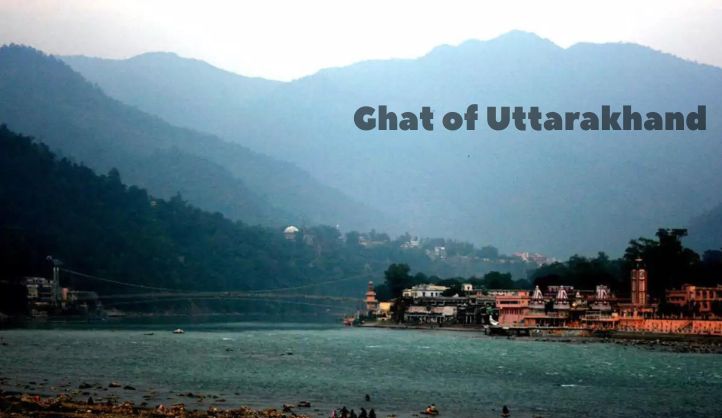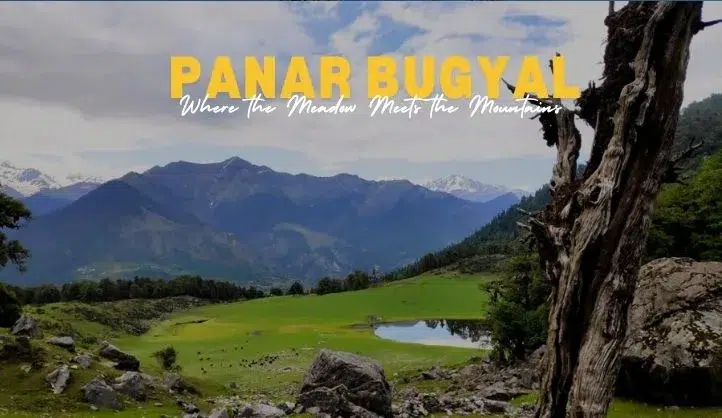Ghat of Uttarakhand, a “ghat” usually refers to a spot along a river where people gather for religious ceremonies, rituals, or simply to bathe. These riverfront locations, often found along the Ganges and other rivers, hold cultural and spiritual significance. Ghats in Uttarakhand are not just riverbanks; they are sacred places where people connect with nature and their spirituality.
Haridwar Ghat
Har ki Pauri:
Regarded as the holiest spot in Haridwar, Har ki Pauri stands as the revered place where the holy Ganges River emerges from the mountains and embarks on its journey through the plains of India. It is also believed to be the place where Lord Vishnu left his footprints.
This sacred ghat is a bustling hub of activity, lined with numerous temples and ashrams dedicated to various deities, including the Har ki Pauri Temple, known for its captivating architecture and grand kumbh mela celebrations. The ghat’s central attraction is the large pool called Har-ki-Pauri, where devotees take holy dips, seeking purification and spiritual rejuvenation.
The air around Har ki Pauri is filled with the chants of devotees, the aroma of incense, and the soothing sounds of traditional music, creating an atmosphere of spiritual immersion. In the evenings, when the ghat is illuminated with thousands of oil lamps, the sight is truly mesmerizing.
Gau Ghat:
Gau Ghat, dedicated to the sacred cow, holds a special place in Hindu mythology. It is believed that Kamadhenu, a wish-granting cow, once bathed in the Ganges at this very spot.
This tranquil ghat is known for its serene atmosphere and stunning views of the Ganges River. The gentle flow of the river, the chirping of birds, and the rustling of leaves create a harmonious symphony, inviting visitors to relax and soak in the tranquility of the surroundings.
Gau Ghat is also home to several temples, including the Gauri Shankar Temple, dedicated to Lord Shiva and Goddess Parvati, and the Gau Ghat Temple, where devotees worship the sacred cow. The ghat’s architecture reflects the traditional style of Uttarakhand, with intricate carvings and sculptures adorning the temples and ghat walls.
Kushi Ghat:
Offering a haven for spiritual seekers and nature lovers alike, Kushi Ghat is a tranquil retreat nestled amidst the serene beauty of Haridwar.
This peaceful ghat is known for its serene atmosphere, making it an ideal spot for meditation, yoga, and introspection. The gentle flow of the Ganges River, the lush greenery, and the soothing sounds of nature create an environment conducive to deep reflection and spiritual connection.
Kushi Ghat is also home to several temples, including the Kushi Ghat Temple, dedicated to Lord Shiva, and the Kedar Nath Temple, dedicated to Lord Shiva in his Kedar form. The ghat’s architecture reflects the traditional style of Uttarakhand, with intricate carvings and sculptures adorning the temples and ghat walls.
Brahma Kund:
Steeped in Hindu mythology, Brahma Kund is believed to be the spot where drops of nectar fell from the sky during the battle between the gods and demons. These drops of nectar are said to possess the power to purify sins and grant liberation.
This sacred kund is located within the Brahmakund Temple, which is dedicated to Lord Brahma, the creator god in the Hindu trinity. Devotees flock to Brahma Kund to take a holy dip in its waters, believing it will cleanse them of their sins and bestow blessings upon them.
The kund’s serene atmosphere, surrounded by the temple’s architecture and the soothing sounds of chants, creates an environment conducive to spiritual immersion and seeking divine grace.
Bhimgoda Ghat:
Named after Bhima, one of the mighty Pandavas from the epic Mahabharata, Bhimgoda Ghat offers mesmerizing views of Har ki Pauri and the surrounding mountains.
This picturesque ghat is known for its tranquil ambiance and its historical significance. The ghat’s name is said to derive from the legend that Bhima, during his exile with his brothers, spent time meditating at this spot.
Bhimgoda Ghat is a popular destination for both spiritual seekers and nature enthusiasts. The ghat’s serene atmosphere, combined with the breathtaking views of the Ganges River and the surrounding mountains, makes it an ideal place for reflection, rejuvenation, and connecting with nature.
Vishnu Ghat:
Dedicated to Lord Vishnu, the preserver god in the Hindu trinity, Vishnu Ghat exudes an aura of peacefulness and tranquility.
This serene ghat is a popular spot for devotees to take holy dips in the Ganges River, seeking blessings and purification from Lord Vishnu. The ghat’s architecture reflects the traditional style of Uttarakhand, with intricate carvings and sculptures adorning the temples and ghat walls.
Rishikesh Ghat
Triveni Ghat:
The largest and most popular ghat in Rishikesh, Triveni Ghat is a sacred confluence of three holy rivers: the Ganges, Bhagirathi, and Saraswati. It is believed that taking a dip in the waters of Triveni Ghat cleanses one of sins and grants spiritual enlightenment.
This bustling ghat is lined with numerous temples and ashrams, creating an atmosphere of spiritual immersion. Devotees gather here to perform rituals, offer prayers, and seek blessings. The ghat is also a popular spot for yoga and meditation sessions, attracting seekers from all over the world.
In the evenings, Triveni Ghat transforms into a vibrant hub of activity, illuminated by flickering oil lamps and the sounds of traditional music and devotional chants. The air is filled with an aura of spirituality and devotion, making it a truly mesmerizing sight.
Laxman Jhula:
An iconic landmark of Rishikesh, Laxman Jhula is an iron suspension bridge spanning the Ganges River. It is a popular spot for tourists to capture breathtaking views of the city and experience its vibrant energy.
The bridge’s name originates from the Hindu epic Ramayana, where Laxman, brother of Lord Rama, is said to have crossed the Ganges River at this very spot. Laxman Jhula is a testament to traditional engineering and offers a unique perspective of the city’s bustling life and the serene beauty of the Ganges.
Crossing Laxman Jhula is an exhilarating experience, offering panoramic views of the river, the surrounding mountains, and the lively city below. The bridge sways gently with the footsteps of pedestrians, adding to the thrill of the crossing.
Ram Jhula:
Another suspension bridge over the Ganges, Ram Jhula is located downstream from Laxman Jhula and offers a less crowded alternative. It’s a charming spot for leisurely strolls and enjoying the river’s scenic beauty.
Named after Lord Rama, the central figure of the Ramayana, Ram Jhula is a popular spot for tourists and locals alike to enjoy the tranquility of the river and the vibrant atmosphere of the city. The bridge offers a peaceful escape from the hustle and bustle of the main tourist areas.
Strolling along Ram Jhula, one can soak in the breathtaking views of the Ganges, the lush greenery lining the riverbanks, and the surrounding mountains. The bridge is a popular spot for photographers to capture the essence of Rishikesh’s natural beauty.
Parmarth Niketan Ghat:
Home to the renowned Parmarth Niketan ashram, a global center for yoga and meditation, Parmarth Niketan Ghat exudes a tranquil atmosphere. It’s a popular destination for spiritual seekers and offers stunning views of the Ganges and the mountains.
The Parmarth Niketan ashram is known for its emphasis on spirituality, peace, and environmental consciousness. It offers a variety of programs and courses on yoga, meditation, and Vedanta philosophy, attracting seekers from all over the world. The ashram’s serene environment and beautiful surroundings make it an ideal place for spiritual rejuvenation and personal growth.
Parmarth Niketan Ghat is also a popular spot for tourists to experience the ashram’s vibrant atmosphere and participate in daily rituals, such as morning prayers and Ganga aarti. The ghat offers stunning views of the Ganges River, the surrounding mountains, and the lush greenery, creating a harmonious blend of spirituality and natural beauty.
Sivananda Ghat:
Housing the Sivananda Ashram, a well-established ashram in Rishikesh, Sivananda Ghat is known for its peaceful ambiance and spiritual significance. It’s a popular spot for holy dips and offers a serene escape for those seeking inner peace.
The Sivananda Ashram is dedicated to the teachings of Swami Sivananda, a renowned spiritual guru who emphasized the importance of selfless service, devotion, and meditation. The ashram offers a variety of programs and courses on yoga, meditation, and Vedanta philosophy, attracting seekers from all walks of life.
Sivananda Ghat is a popular spot for devotees to take holy dips in the Ganges River, seeking purification and spiritual enlightenment. The ghat’s serene atmosphere, surrounded by the ashram’s tranquil gardens and the sounds of chanting and devotional music, creates an environment conducive to deep reflection and spiritual connection.
Gita Ghat:
Named after the Bhagavad Gita, the Hindu scripture, Gita Ghat offers a tranquil retreat for meditation and yoga. It’s a place for deep reflection and spiritual connection, surrounded by the serene beauty of the Ganges.
Swargashram Ghat:
Home to the Swargashram ashram, known for its traditional practices and strict discipline, Swargashram Ghat offers a unique spiritual experience. It’s a place for those seeking a deeper understanding of Hindu traditions and spiritual enlightenment.
The Swargashram ashram is dedicated to preserving and upholding traditional Hindu practices, emphasizing simplicity, discipline, and devotion. The ashram follows a strict daily routine, including early morning prayers, meditation sessions, and various religious rituals.
Swargashram Ghat is a popular spot for those seeking a deeper immersion in Hindu traditions and spiritual practices. The ghat’s serene atmosphere, surrounded by the ashram’s traditional architecture and the sounds of chanting and devotional music, creates an environment conducive to spiritual growth and self-discipline.
Neelkantha Ghat:
Named after Neelkanth Mahadeva, a temple dedicated to Lord Shiva, Nilkantha Ghat is a picturesque spot with stunning views of the Ganges and the surrounding mountains. It’s a popular destination for both religious and recreational activities.
Neelkantha Ghat is known for its tranquil atmosphere and its association with the Nilkantha Mahadeva temple, a revered shrine dedicated to Lord Shiva. The temple is believed to be the spot where Lord Shiva consumed the deadly poison that emerged during the churning of the ocean, turning his throat blue (nilkantha).
The ghat is a popular spot for devotees to offer prayers and seek blessings from Lord Shiva. The serene atmosphere, surrounded by the temple’s architecture and the sounds of chanting and devotional music, creates an environment conducive to spiritual connection and reflection.
In addition to its religious significance, Neelkantha Ghat is also a popular destination for recreational activities, such as swimming, boating, and trekking. The ghat offers stunning views of the Ganges River, the lush greenery lining the riverbanks, and the surrounding mountains, making it a picturesque spot for nature lovers and adventure seekers.
Conclusion:
Ghats are important cultural, religious, and social landmarks in Uttarakhand. They are used for a variety of purposes, including bathing, washing clothes, performing religious rituals, and tourism. Ghats are also popular tourist destinations, as they offer stunning views of the rivers and are often surrounded by temples and other religious buildings.
FAQ for Ghat of Uttarakhand
What is a ghat?
A ghat is a series of steps leading down to a river or other body of water. They are often used for bathing, washing clothes, and performing religious rituals. Ghats are also popular tourist destinations.
What are the ghats used for?
Ghats are used for a variety of purposes, including:
- Bathing: Many people believe that bathing in the holy waters of the Ganges River will cleanse their sins.
- Washing clothes: Ghats are often used for washing clothes, as the river water is considered to be purifying.
- Performing religious rituals: Many Hindus believe that performing religious rituals at a ghat will bring them good luck.
- Tourism: Ghats are popular tourist destinations, as they offer stunning views of the rivers and are often surrounded by temples and other religious buildings.
What is the significance of ghats?
Ghats are significant for a number of reasons, including:
- Religious significance: Ghats are considered to be holy places by many Hindus.
- Cultural significance: Ghats are an important part of Hindu culture and have been used for centuries.
- Social significance: Ghats are often used as meeting places for people from all walks of life.
- Economic significance: Ghats are a major source of tourism revenue for Uttarakhand.
What are the different types of ghats?
There are two main types of ghats:
- Public ghats: These ghats are open to the public and are used for a variety of purposes, including bathing, washing clothes, performing religious rituals, and tourism.
- Private ghats: These ghats are owned by individuals or families and are typically used for private religious ceremonies.
What are the best times to visit the ghats?
The ghats are open 24 hours a day, but the best times to visit are during the early morning or evening hours, when the crowds are smaller and the weather is cooler.
What should I wear when visiting the ghats?
It is important to dress modestly when visiting the ghats. Men should wear shorts or pants that cover their knees, and women should wear skirts or dresses that cover their shoulders.
Are there any special rules or etiquette that I should follow when visiting the ghats?
Yes, there are a few special rules or etiquette that you should follow when visiting the ghats:
- Be respectful of other visitors: The ghats are a place of worship for many people, so it is important to be respectful of others.
- Remove your shoes before entering the water: This is a sign of respect for the holy water.
- Do not litter: Please help to keep the ghats clean by disposing of your trash properly.
Where can I stay when I visit the ghats?
There are a variety of hotels and guesthouses located near the ghats in Haridwar and Rishikesh. You can also find camping and dormitory accommodations if you are on a budget.
How can I get to the ghats?
The ghats in Haridwar and Rishikesh are well-connected by public transportation. You can also take a taxi or rickshaw from the airport or train station.









